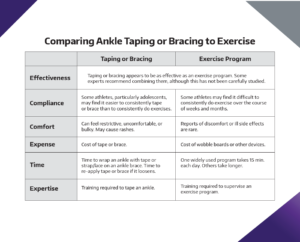
Ankle Sprain Prevention: What Works?
Ankle sprains routinely top the list of most common sports injuries, sidelining promising middle-schoolers and decorated pros alike. In any given youth basketball or soccer season, odds are at least one player has one.
Preventing sprains and other ankle injuries would be a boon to humankind. Taping, bracing and certain exercise programs all help. What does the research say about these prevention strategies and which athletes benefit the most?
6 frequently asked questions
Here are the answers to 6 frequently asked questions about prevention of inversion ankle sprains, the most common type.
1. Why does prevention matter?
Ankle injuries take a huge toll on athletes, both in the short term and over time. Although symptoms usually improve in the first couple days or weeks, full recovery can take up to six weeks, and symptoms often linger for up to a year. Repeat sprains and chronic ankle instability can hobble active boys and girls over their lifespan, limiting the things they want and need to do into adulthood and retirement.
2. Which sports have the most sprains?
Among college athletes, men’s and women’s basketball players are most likely to have an ankle sprain–about 40 out of 100 players have one during a full season. By comparison, out of 100 college soccer or football players playing a full season, eight or nine will have one. In youth sports, basketball players are also the most vulnerable, about three times more likely than soccer players to suffer a sprain.
3. How much do taping and bracing help?
Research consistently shows that wrapping an ankle in tape or supporting it with a brace can prevent an ankle sprain. These methods are more effective for preventing repeat injuries than first-time injuries.
- In a study of boys and girls basketball teams at 46 Wisconsin high schools, players randomly assigned to wear lace-up ankle braces had about one-third as many first-time ankle injuries as players who did not wear a brace—26 compared to 75. On average, about one ankle injury was prevented per season on the teams where players wore braces. Other studies have shown similar reductions in risk.
- When taping is compared to bracing, the two are similarly effective. “The use of a brace or tape is a personal choice and based on practical usability and costs,” the authors of a 2018 international guideline
- Reducing ankle motion with taping or bracing does not appear to increase the risk of knee injuries or other problems, as some have feared.
- There is not enough research on the use of elastic bandages to know whether they may prevent ankle injuries.
4. Can an exercise program reduce ankle sprains?
As with taping and bracing, most research suggests that ankle-specific exercise programs can reduce the chance of a repeat sprain. But there is not enough good research to say whether training can reduce the chance of a first sprain.
Researchers have studied preventive exercises across a broad range of age groups and sports. A few studies have examined training in young boys and girls ages 12-18. One study looked at young men and women playing recreational volleyball. Others assessed the impact of preventive exercises in professional soccer and basketball players.
- Authors of a 2015 review analyzed seven moderate- to high-quality studies in different age groups and sports. Each study compared the addition of an ankle sprain prevention program to standard training such as warmups. The prevention programs significantly reduced sprains in athletes who had a previous sprain. “This equates to approximately one ankle sprain being prevented per sporting team,” the authors concluded.
- A more recent 2018 review reached a similar conclusion. “Exercise therapy such as coordination and balance training mainly seem to be effective for recurrent ankle sprains up to 12 months after the initial sprain, but not on first-time ankle sprains,” the authors wrote.
5. What are the components of a successful training program?
- There is no single program recognized as the standard.
- Successful prevention programs usually emphasize balance training and “proprioceptive” exercises that challenge ankle joint position. They employ balance boards, wobble boards or ankle discs along with other exercises such as standing on one leg. Athletes do these exercise at home or during team practice.
- One widely used Canadian program begins every practice with a 15-minute warmup that includes stretching, strength, agility and balance exercises.
- The amount of time devoted to training may vary from as little as 20 minutes per week to as long as 150 minutes per week. One program ran for four weeks in the preseason, but another for nine months.
6. What about high-top shoes?
The influence of footwear remains unclear. In three ankle-sprain prevention studies that randomly assigned athletes to wear either high-top or low-top shoes, neither style offered an advantage. Results from other studies are inconsistent.
Weighing the options


